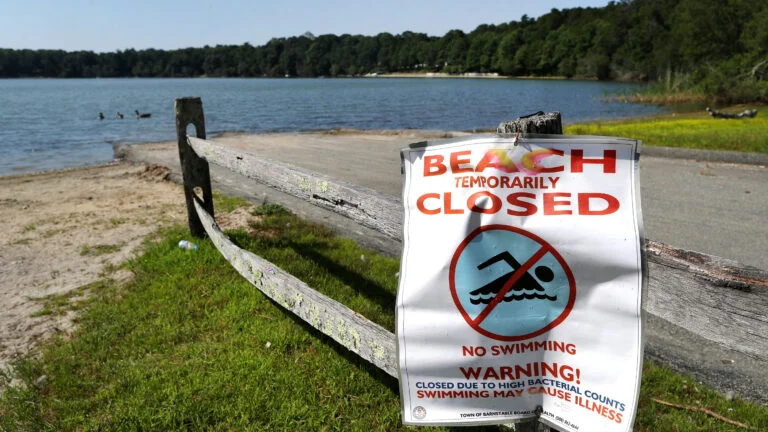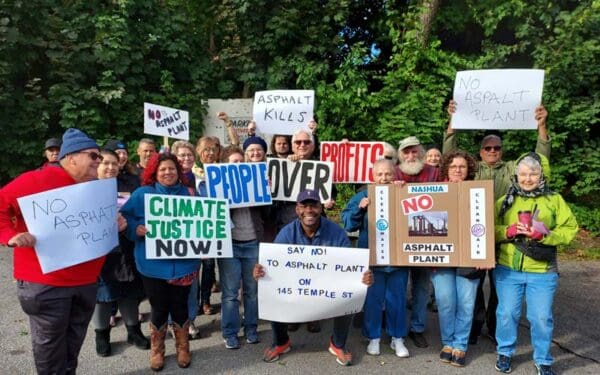
Climate change and polluted stormwater runoff fueled widespread beach closures in 2023. Photo: Courtesy Boston Globe/John Tlumacki.
The air is thick and sultry. The temperature is in the high 80s. What better time to head to the nearest pond, lake, or beach for a cooling dip?
Many of us have tried to do exactly that this summer, only to be greeted once we’ve reached that cool body of water by ominous signs: “Warning! No Swimming Due to Elevated Bacteria Levels.”
The signs are everywhere. In Massachusetts alone, more than 70 beaches have been deemed unsafe for swimming due to high bacteria levels and harmful algal blooms. Beaches have been closed in Rhode Island and Connecticut, and fecal bacteria advisories have been posted in New Hampshire and Maine. At Lake Champlain, in Vermont, swimmers were warned away after the intense rainstorms that triggered extensive flooding statewide also caused stormwater runoff to inundate the lake. To make matters worse, a sewage pipe broke under the Winooski River, allowing about 10% of Burlington’s wastewater to flood into the river and Lake Champlain.
In short, our beaches, lakes, and rivers are becoming toxic stews that could hardly be less inviting on a hot summer’s day. Depending on where you are, the harmful bacteria may come from sewer overflows or an overabundance of nitrogen and phosphorus caused by antiquated septic systems and fertilizer runoff. Especially troubling is that more intense and frequent downpours caused by climate change will result in more polluting stormwater runoff everywhere, potentially making our beach-combing days a fond memory. But it doesn’t have to be this way.
A Toxic Soup Served at Your Nearest Beach
After heavy rain, stormwater courses down our streets, across strip mall parking lots, over office park roofs, and fertilized lawns – ultimately pouring into storm drains. Those drains move all that water, polluted with debris, pesticides, metals, chemicals, fertilizers, and oil, through underground pipes into our waterways.
In fact, some 11 million gallons of oil and gas – equivalent to the Exxon Valdez spill – run off America’s streets, parking lots, and driveways every eight months, according to the Pew Oceans Commission. In addition, discharges from combined sewer overflows, which collect rainwater runoff, domestic sewage, and industrial wastewater in one pipe, are common. They happen whenever runoff that normally flows to a wastewater treatment plant is inundated with more waste than the sewer pipes can handle. When the system is overwhelmed, untreated stormwater and raw sewage course through pipes and end up at your nearest beach. With the more frequent and intense rainstorms caused by climate change, overflows are happening more frequently.
And with these overflows, there’s a lot more at stake than just a missed swim. Water contaminated with fecal matter and toxic algae can taint drinking water, sicken pets, and kill off fish, frogs, and other aquatic life.
Our stormwater headaches result from our asphalted and concretized surroundings. Stormwater pollution wasn’t an issue when New England’s landscape was largely one of forests, fields, and meadows. In a natural restorative cycle, the ground absorbed rain, filtering any pollution long before it drained into our waterways.
While we can’t reverse development and turn office parks and malls back into nature preserves, we can take specific steps now to address the stormwater issue. We know that this problem will intensify in the coming years, and there’s no reason to let our environment and quality of life go, well, down the drain.
Holding Polluters Accountable
To begin with, large private property owners, including universities, office parks, high-density residential buildings, and shopping malls, must be held accountable for the toxin-laden rainwater spilling off their grounds. Although they are the primary source of the pollutants being dumped into our waterways, these large entities are currently not required to limit or pay for their stormwater runoff. This must change. Otherwise, cities and towns will remain on the hook for both the cost and consequences of the toxic water.
In addition, local governments should carefully assess sewer infrastructure. Every town and city should act now to update outdated septic systems and old sewer pipes, knowing that climate-induced storms will only worsen in the coming years. Our pipes need to be up to the job.
Finally, both large and small property owners need to rethink landscaping practices. Fertilizers are a major source of stormwater contamination. Fertilizing by just one excess pound on an average lawn can result in 34 pounds of excess algae growth in local rivers and streams. Grass clippings and leaves are also a huge source of pollution. The amount of phosphorus in grass clippings from mowing a lawn just once can result in 100 pounds of algae in waterways. About 56% of nitrogen and phosphorus in urban stormwater derives from leaf litter and landscape waste. Composting leaves, dispensing with fertilizer, and directing gutter downspouts onto lawns and flower beds instead of pavement, can all help.
Embracing Green Infrastructure
In concert with cracking down on stormwater polluters, we must embrace green tools at our disposal. While we may not have the woodlands and vast fields of yesteryear, we can approximate their powerful water-capturing capabilities through “green infrastructure.” Green infrastructure harnesses the power of natural landscapes to soak up precipitation and filter pollutants before polluted runoff ever reaches waterways. Green infrastructure can include planting shrubs and grasses on the roofs of apartment and office buildings to absorb rainwater. It can encompass rain gardens – depressed areas planted with grasses and flowers that soak up rainwater – in parking lots and alongside strip malls and housing developments.
And it can even include the simple principle of incorporating more parks, natural borders, and trees as part of our cityscapes. The benefits of these green spaces are many, as neighborhoods with many parks and trees are significantly cooler during heat waves. Such green spaces can also help reduce the chance of flooding during extreme storms.
Permeable pavement, that can soak up rainwater and melting snow like a sponge, is another important tool to counter stormwater runoff. Many towns and cities already use this type of high-tech pavement, including Chicago, Philadelphia, Los Angeles, and Baltimore. Regionally, Boston and smaller towns like Hingham, Massachusetts, and South Portland, Maine, are jumping on board.
Restoring Wetlands
As cities and towns remake themselves to incorporate more green, spongy surfaces that can soak up a good pelting when the next storm hits, they must also restore and protect wetlands. Wetlands play a critical role in watershed dynamics. They recycle nutrients, filter pollutants, recharge groundwater, and provide habitat for fish and wildlife. But they play another role too. During intense storms, wetlands can absorb runoff, reduce flood damage, and protect shorelines that might otherwise erode. Across New England, in Rhode Island, Connecticut, Massachusetts, Vermont, Maine, and New Hampshire, people are beginning to wake up to the importance of wetlands as a climate resiliency strategy.
This summer has shown us the future if we don’t close the tap on our stormwater runoff problem. As we are pummeled by more frequent and powerful storms that unleash torrents of water from the sky, we need a better strategy for handling the deluge. Otherwise, a day at the beach (or on the lake or at the pond) could become just a thing of the past.




